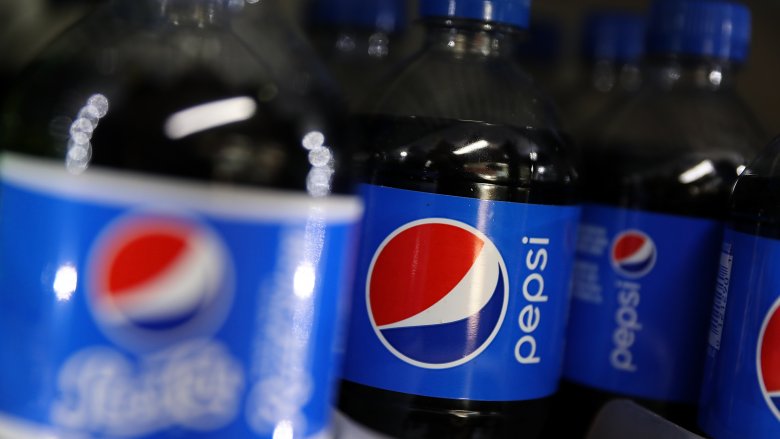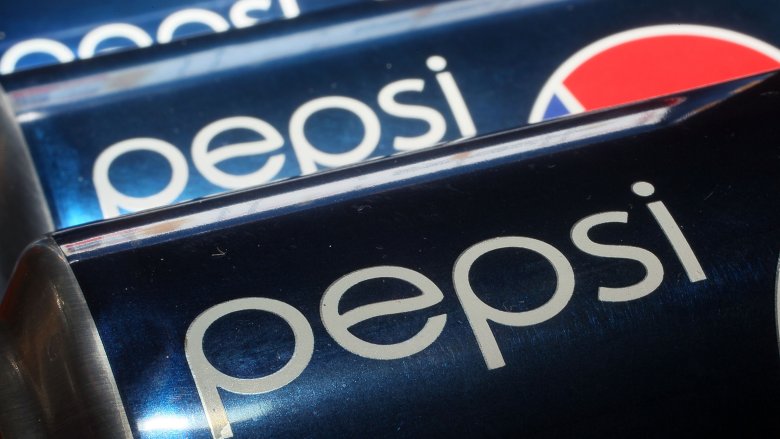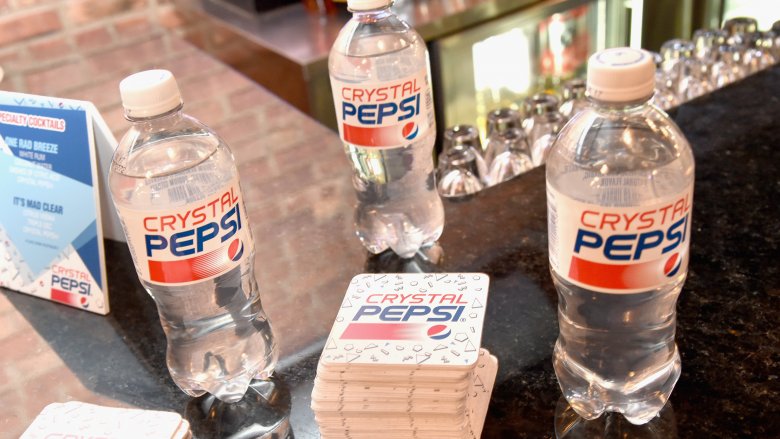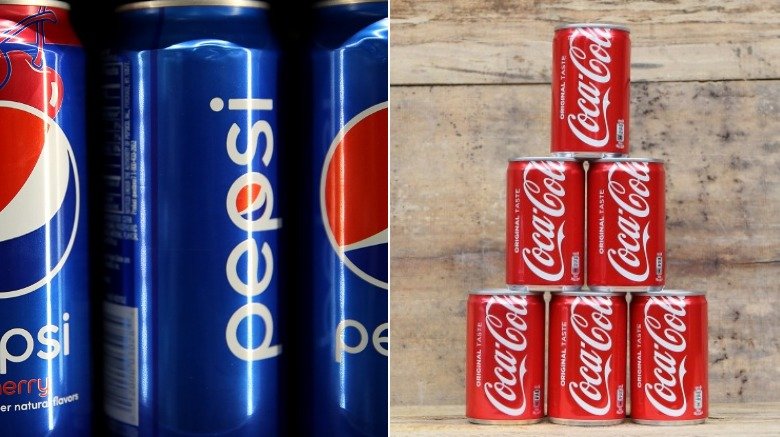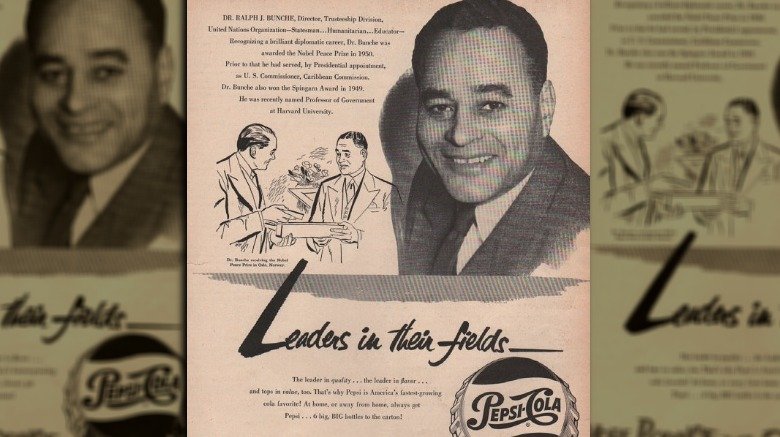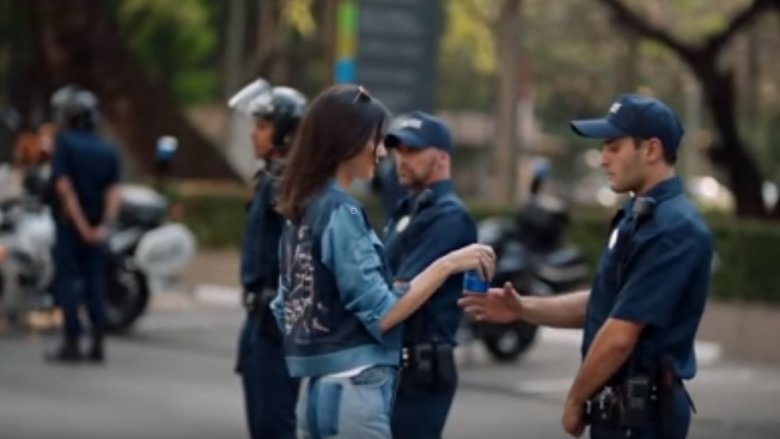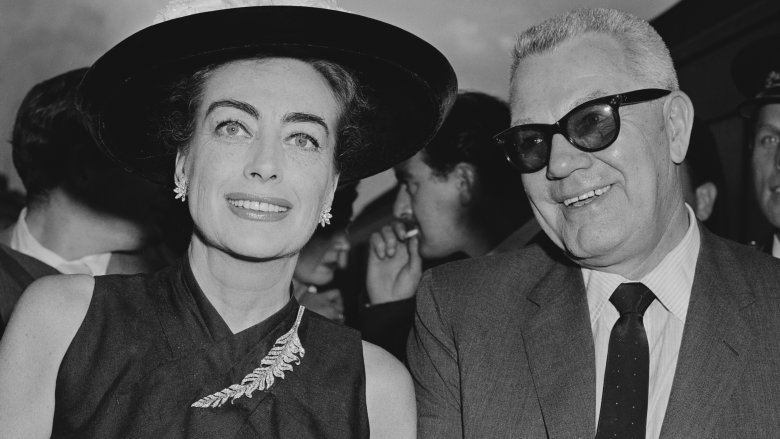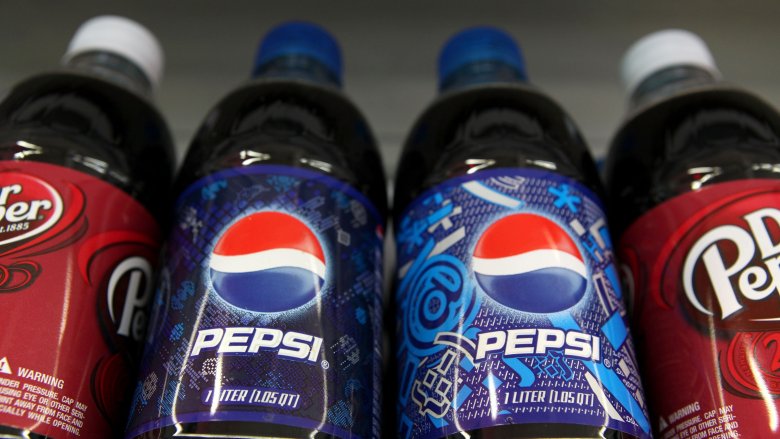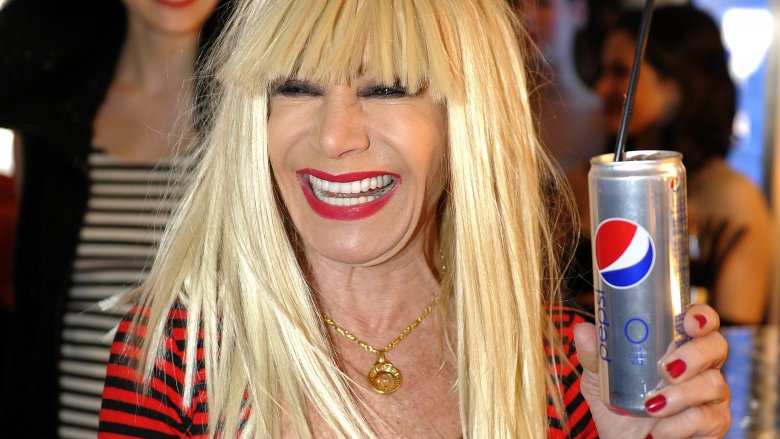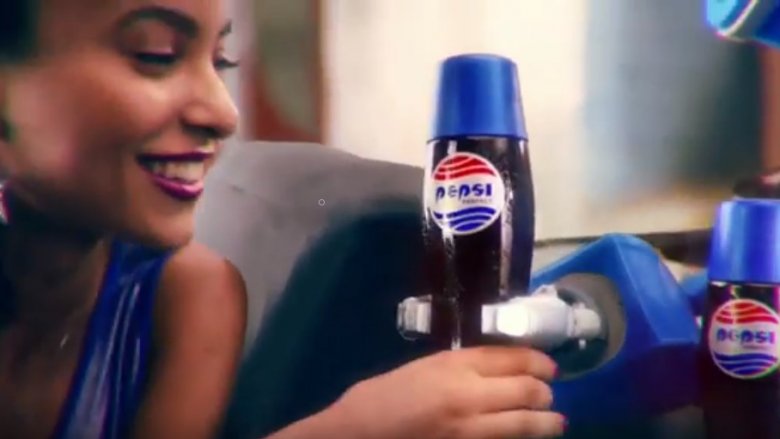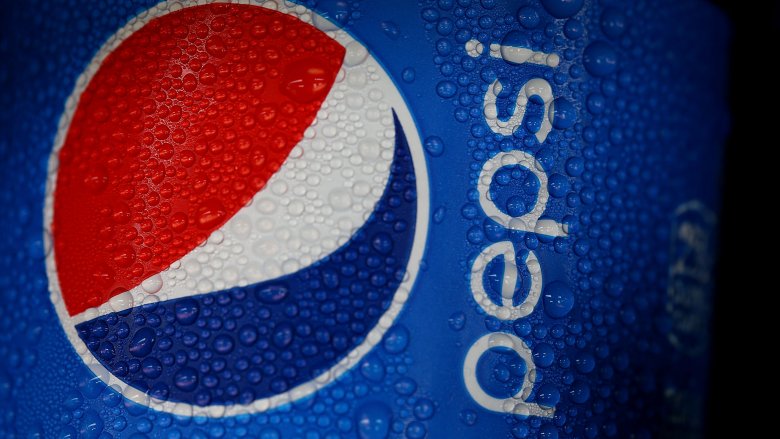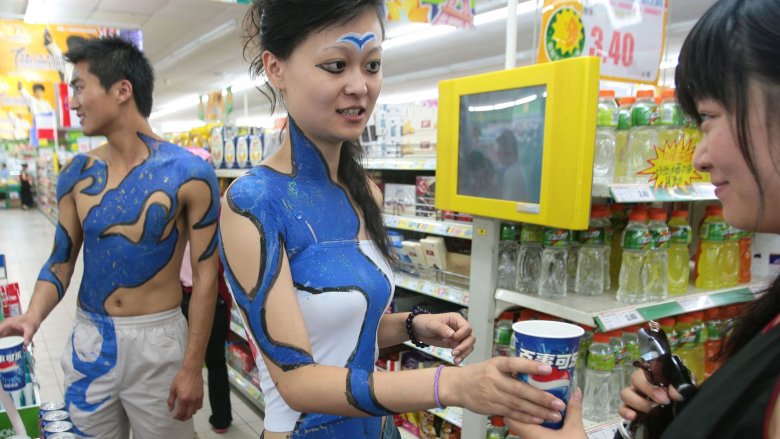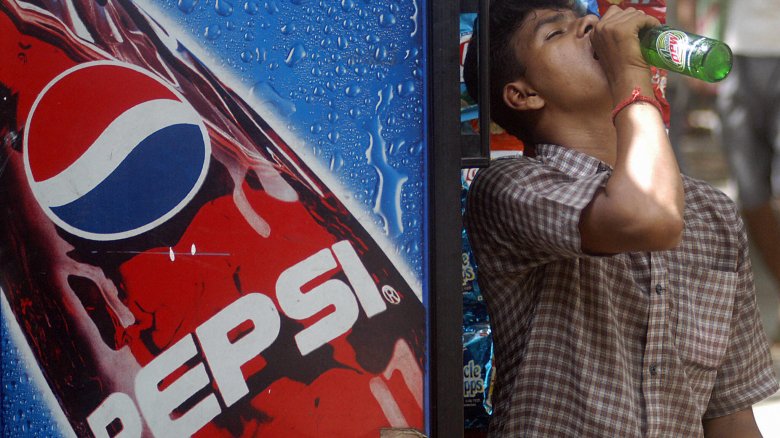The Untold Truth Of Pepsi
You can tell a lot about a person by the choices they make. Rock or country? Beer or wine? Coke or Pepsi?
If you said Pepsi, you're actually on the side of the new kid on the block. Pepsi was developed 13 years after Coke hit the market in 1886, and by 1904, Coke was already selling more than a million gallons a year. That's a huge competitor to take on, and Pepsi absolutely did.
According to Business Insider, it was a rocky start. Coke expanded overseas, opened plants in Paris, Bordeaux, and the Philippines, while World War I rationing bankrupted Pepsi in 1923... and they went bankrupt again in 1931. But by 1939, they released the first ever advertising jingle, changed their logo to the now-familiar red, white, and blue at the eve of World War II, and the world's two colas were going head to head to try to outdo each other. They're still going at it today, and even though Coke might be more popular, Pepsi-lovers can wear something of a badge of pride knowing they're supporting the longtime underdog. There are a ton of fascinating tidbits you probably don't know about Pepsi, so let's talk about the other cola.
"Pepsi" comes from a word for indigestion
Most companies today might want to give their product a name that inspires someone to buy it — something noble, or dignified, or just saying how awesome it is. But Pepsi? It's a weird word, and it comes from a weirder place, says The Pepsi Store.
The drink was invented by a pharmacist and schoolteacher named Caleb Bradham. He came up with the formula in 1893 while he was working at his drug store in New Bern, North Carolina, and he called it Brad's Drink. It was an all-natural mix of water, sugar, lemon oil, caramel, nutmeg, and a few other simple ingredients, and people loved it. On August 28, 1898, he officially changed the name of his popular drink. Since he had originally sold it to help with indigestion, he took the word "dypepsia" (which literally means "indigestion"), and shortened it to "Pepsi." He tacked -Cola on the end, and by 1902 he was the president of his own company.
Crystal Pepsi got taken down by Coke
Lots of companies have products that fail, but when Pepsi came out with a novelty product that was a clear cola, it didn't just fail because people didn't like it. It failed in large part because Coke had a hand in its downfall.
According to 11 Points, Pepsi poured $40 million into the development of Crystal Pepsi. Then-CEO David Novak has said it did really well in test markets, and they were sure they had a winner on their hands. It went mass-market in April 1992, and about six months later Coke answered with Tab Clear. It was horrible, and it was intentionally horrible.
Not wanting to tarnish the image of Coca-Cola in the slightest, they used their least popular offshoot brand (Tab) to make a clear soda that would help confuse customers. Was it a diet drink? Was it a girls' drink? No matter what it was, it was bad — and since Tab was so bad, that soured the market on clear colas altogether. Their intentionally bad product helped take down Pepsi's brilliant idea, and that's some seriously diabolical marketing.
Pepsi helped save Coke
By 2006, the Cola Wars had been raging for decades. You'd think Pepsi would trip over themselves to get their hands on Coke's secret syrup, but they took the high road when they had the opportunity to do exactly that.
The whole saga was like something out of a spy movie, and it started with Joya Williams. She was an assistant to Coke's global brand director, and when she got a whole of a vial of Coke's new product, she went to Pepsi. She'd hand it over, she told them, for $1.5 million.
Pepsi didn't bite — instead, they went to the FBI.
According to The Guardian, the FBI — along with help from both Coke and Pepsi — set up a sting operation that ended with conspirators exchanging the vial for a Girl Scout cookie box filled with $30,000. They were ultimately arrested, and Pepsi spokesman Dave DeCecco had this to say (via Fox News) about their part: "Competition can sometimes be fierce, but also must be fair and legal. We're pleased the authorities and the FBI have identified the people responsible for this."
Pepsi broke color barriers
When the University of Pennsylvania looked at the history of Pepsi's marketing, they credited them with an advancement that had nothing to do with cola at all: they kicked open the door to diversity in corporate America.
In 1940, then-president of Pepsi-Cola Walter Mack made what was a bold move at the time: he hired an black adman named Herman T. Smith. The idea was that they were going to expand Pepsi's target audience into minority communities that had previously been ignored thanks, in part, to Coca-Cola's good ol' boy Southern mentality.
Then, in 1947, Mack hired salesman Edward F. Boyd to lead a sales team tasked with heading into still-segregated areas of America with a new ad campaign that featured African Americans. It was a big deal, and Boyd said (via The Los Angeles Times), "We'd been caricatured and stereotyped. The advertisement represented us as normal Americans." They faced Jim Crow laws and death threats from the Ku Klux Klan, but they changed corporate America.
But they've had a complicated relationship with race
Pepsi's most high-profile misstep when it comes to racial insensitivity was Kendall Jenner's 2017 commercial, where she appeared to stop all sorts of conflicts by just handing out some Pepsi. Pretty much no one liked it and the outrage was as immediate as it was widespread — and it's not the first time Pepsi was accused of racial insensitivity.
Vox looked at just how much Pepsi (and Coca-Cola) spent on marketing that targeted minority groups, and found soda ads as a whole ran an average of three to four times as often in minority communities. In 2013, Pepsi led the way and spent $33.6 million on ads targeting Hispanic groups alone, and pushing their Pepsi Limon, designed to appeal to the same demographic. The Rudd Center for Food Policy & Obesity went one step further, and accused soda companies of making health problems even worse for minority communities already struggling with diet-related diseases, particularly considering children and young adults were some of the most common targets for advertising campaigns.
Joan Crawford and Pepsi
Joan Crawford made Hollywood history for her feud with Bette Davis, but less famous than that is Crawford's devotion to Pepsi.
Crawford's fourth husband was Alfred Steele (pictured with her), and he was a longtime businessman and chairman of the board at Pepsi. He ultimately died of a heart attack in 1959, and Crawford was devastated. But she was also in a position to honor his memory by stepping into his shoes — and she did. She was a brilliant businesswoman in her own right, and when she took his position on Pepsi's board, it wasn't just as a famous figurehead. Crawford made business decisions, appearances, and even visited Pepsi plants (via Marion Illinois History Preservation), where she talked about what it was like in the business world — which was, at the time, still very much a man's world.
She served on Pepsi's board until 1973 — only four years before she died, says Campaign, once saying, "Every time you drink a Pepsi, I want you to think of Joan Crawford. If you drink a Coke, you can think of those polar bears."
Failed Pepsi products you forgot about
Remember Pepsi Blue? It was their answer to Coke Vanilla, and it was a super-sweet, berry-flavored soda that ended up causing some big problems. Business Insider says the demise of this one came when people were outraged over the use of Blue 1, a dye banned in some countries. How about Josta? That was Pepsi's early foray into the world of the energy drink, and that was only around for about four years in the '90s.
Anyone who's a fan of Mad Men might remember Don Draper pitching ideas for Patio Diet Cola, and it really was a Pepsi product released in 1963. It was an early diet soda that failed only a year later, and eventually became the less oddly-named Diet Pepsi.
There's also been the very strange Pepsi AM (the breakfast soda), Pepsi Wild Bunch (a three-pack of strawberry, tropical, and raspberry-flavored Pepsi), Diet Pepsi Jazz (in the weird flavors of strawberries and cream, caramel cream, and black cherry/french vanilla), and Mountain Dew Sport, a version of Dew that Mental Floss says was supposed to take on Gatorade. It didn't.
Remember their terribly tone-deaf "skinny" can?
There are some products that just leave consumers wondering what the heck they were thinking, and in 2011, the world was left wondering that about a new Pepsi release. It came out for New York's Fashion Week, and the tall, skinny can was marketed as a "taller, sassier" version of Pepsi made in "celebration of beautiful, confident women"... who were, presumably, that way just because they were also super-thin. Their official statement read, in part (via CBC News), "Our slim, attractive new can is the perfect complement to today's most stylish looks..."
It was a sentiment that had all kinds of critics, especially, says NPR, the National Eating Disorder Association. They called it "thoughtless and irresponsible", and that wasn't even in response to the cringiest moment of their Diet Pepsi campaigns.
In 2013, they released a blue and grey, peacock-patterned can. That's fine, but when marketing director Amy Spiridakis spoke with AdWeek (via The Journal), she revealed who they had in mind when they developed the new look for Diet Pepsi: "It's targeted at females who love home design."
Um... okay?
They made a fictional Pepsi come true
Back to the Future is one of those movies that everyone loved, and when October 21, 2015 rolled around, there was a ton of buzz about it. It was the date Marty McFly headed to when he went into the future in the second installment of the series, and while we might not have had hoverboards and all the other cool stuff he found there, Pepsi made sure we had one of the things Marty found in his future: Pepsi Perfect.
Pepsi released a super-limited number of them, and 6,500 bottles went on sale on October 21. They also gave some away at New York Comic Con, handing out bottles to con attendees who came dressed in Marty's trademark puffy red vest and white high-tops, and they also gave them away to attendees who impressed at the Wild Gunman arcade game.
So, the million-dollar question: what does the Pepsi of the future taste like? While many collectors might be tempted to save their bottles as-is, CNET opened theirs and reported it tastes just like regular Pepsi. But futuristic!
It wasn't contaminated with HIV
The food industry has more than a fair share of urban legends, and Pepsi has been the target of one of the most bizarre. It's so far-fetched it's hard to believe... but it's horrible enough that people might steer clear of Pepsi just in case.
The story goes that a disgruntled employee contaminated a batch of Pepsi by adding HIV-infected blood, and it's just not true. Snopes says the story first showed up in 2011, and it's made a reappearance several times since.
Even the Centers for Disease Control and Prevention came forward to say they not only had no reports of any such incident happening, but even if it did, it wouldn't be deadly as HIV can't live outside the human body. You still wouldn't want to drink it, sure, but Snopes also says this sort of story is pretty common when it comes to food urban legends. There are a ton of rumors about foods that have been contaminated at the factory, so don't worry — this one isn't true.
They may have made some weird promises to China
Pepsi is a global company, but there's a weird thing that may — or may not — have happened in China in the 1960s. It's so weird that Snopes says we're not even sure if it's true, and don't worry, it gets stranger.
Between 1963 and 1967, Pepsi's slogan was, "Come Alive! You're in the Pepsi Generation," and we all know that some things just don't translate. There's a rumor that Pepsi's sales in the Chinese market dropped during this period because it didn't translate into the inspirational, go-get-'em slogan they had in mind, but instead implied drinking Pepsi was going to somehow raise the dead. That's a whole different meaning to "come alive," and we have no idea if it's true.
There are so many dialects in the Chinese language and the story doesn't specify a location, so it's impossible to tell whether or not there were people in the '60s who were turned off from Pepsi because of a mistranslation. Pepsi is weirdly mum on the subject, and they've never debunked the story they accidentally marketed to China with a slogan like, "Pepsi will bring your ancestors back from the dead." True or not, it just goes to show how important translation is.
Pepsi as a pesticide?
There's a certain part of the population that wants to condemn sugary sodas and all the ill effects they're said to have on our health, but one story out of Asia was even more terrifying than all the fearmongering of the West. According a 2004 report from The Guardian, farmers in India were bypassing all the high-priced pesticides and chemicals and using Pepsi (along with Coca-Cola and local soda Thums Up) as pesticides on their crops. Indian agriculturists say the sugary sodas were actually attracting ants, which then ate the larvae of insects damaging the crops. That's... pretty brilliant, but it can also sound terrifying.
Pepsi and Coca-Cola both said there was nothing dangerous in their sodas that could possibly act as a pesticide (via the BBC), but rumors persisted that the sodas were doing the killing, not just attracting other insects to do pest control. NPR says in 2006, an investigation by The Center for Science and the Environment found both sodas contained "unacceptably high levels of pesticide," and they were banned — though the government of India said their tests were flawed. The ban was eventually overturned, but bad feelings about the drinks remained. Pepsi and Coke both fought back, but it turns out that not all publicity is good publicity after all.
